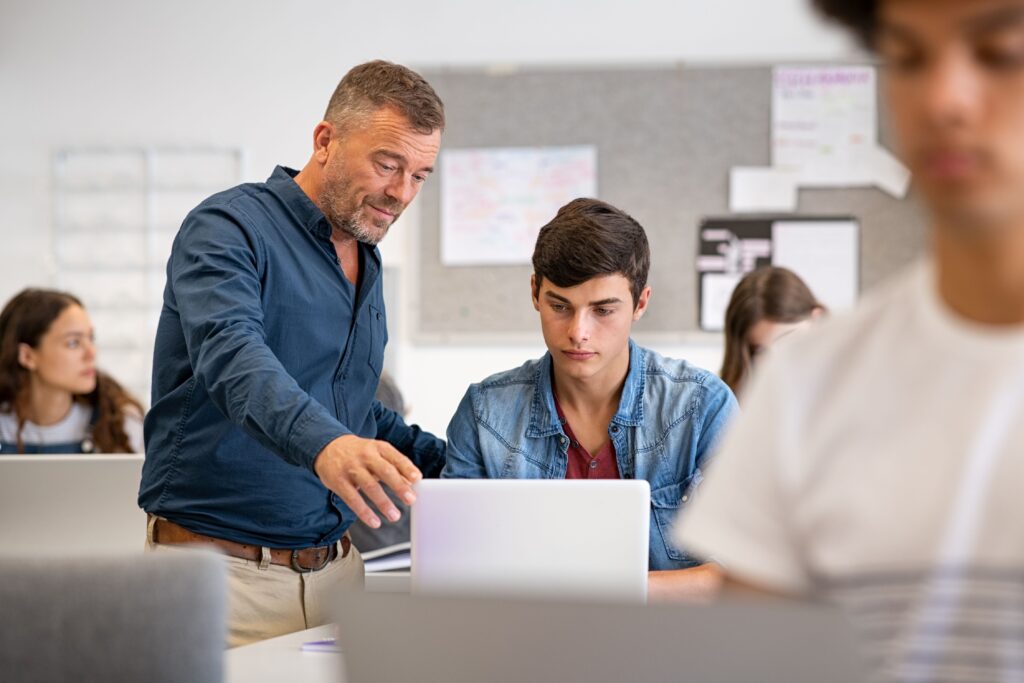Remember a time not so long ago when the biggest tech challenge in your classroom was getting the VCR to stop flashing “12:00”? We used overhead projectors, chalkboards, and stacks of paper. The digital world was something we taught about, not something we taught with.
Today, that world has moved into our classrooms, our lesson plans, and our students’ pockets. The question is no longer if we should use technology, but how. This is where digital literacy comes in, and for today’s educators, it’s not just a nice-to-have skill—it’s a non-negotiable.
What Is Digital Literacy for Educators?
At its core, digital literacy is more than just being able to use a computer or tablet. It’s a multifaceted skill set that encompasses a wide range of competencies.
Think of it as the modern equivalent of traditional literacy. Just as reading and writing allow us to consume and produce written information, digital literacy allows us to navigate, evaluate, and create content within the digital landscape. For a comprehensive framework of what this entails, you can explore the International Society for Technology in Education (ISTE) Standards for Educators.
Just as reading and writing allow us to consume and produce written information, digital literacy allows us to navigate, evaluate, and create content within the digital landscape.
It can be broken down into three key areas, each critical for K-12 education:
Technical Proficiency
This is the foundational layer—the hands-on ability to operate hardware and software effectively. This includes everything from seamlessly using a learning management system (LMS) like Google Classroom or Canvas to troubleshooting a projector or creating a professional-looking presentation.
This isn’t just about knowing what the buttons do, but about confidently integrating these tools into your daily workflow to maximize efficiency.
Information Literacy
In the age of endless information, this is arguably the most crucial skill we can teach. It’s the ability to find, evaluate, and synthesize information from digital sources.
For teachers, this means modeling how to identify credible sources, recognize misinformation and “fake news,” and understand the concept of bias. Our role extends beyond providing information; we must teach students how to think critically about the information they find online.
Digital Citizenship
This area focuses on the ethical and responsible use of technology. It includes understanding online safety, practicing good “netiquette,” protecting personal privacy, and recognizing the permanence of one’s digital footprint.
Teaching students to be responsible digital citizens is vital for their long-term well-being and success in a connected world. We are their first line of defense and guidance in this often-complex space.
Why Digital Literacy is Now a Core Competency for Teachers
Embracing digital literacy doesn’t just make our jobs easier; it fundamentally changes the learning environment for the better and aligns our teaching with the demands of the 21st century.
Enhanced Student Engagement and Learning Outcomes
Digital tools can transform a static lesson into an interactive, dynamic experience. Think about using virtual field trips to explore historical sites, or educational apps that provide immediate, personalized feedback to students.
When you’re digitally literate, you can leverage these tools to make learning more hands-on and engaging. Research from organizations like the International Society for Technology in Education (ISTE) shows that students who use digital resources often develop higher-order thinking skills and perform better academically.
Personalized and Differentiated Instruction
Every student has unique needs and learning styles. Digital literacy empowers you to create personalized learning paths. You can use platforms to assign different resources to different students, allowing them to work at their own pace.
For a student who excels at visual learning, you might provide a video tutorial, while another who prefers text might get a scientific article. This level of customization was nearly impossible in a traditional, non-digital setting.
Preparation for a Digital Future
The job market our students will enter is a digital one. Whether they become an engineer, a marketing professional, a plumber, or a painter, they will need to be proficient in using technology. By teaching them digital skills—from creating a compelling presentation to collaborating on a shared document—we are preparing them for success long after they leave our classrooms. We’re not just teaching content; we’re teaching lifelong skills.
Practical Steps for Teachers to Improve Digital Literacy
We understand that the idea of mastering new technologies can feel overwhelming. Many of us didn’t grow up with this tech, and the pace of change is dizzying. One of the biggest challenges for educators is a lack of adequate professional development and resources. It can be hard to implement new tools if you don’t feel confident using them yourself.
Practical Strategies to Take Action Now:
- Start Small: You don’t have to overhaul your entire curriculum at once. Pick one tool, like a collaborative whiteboard app or an online quiz platform, and try it out with a single lesson. Get comfortable with it before you move on to the next.
- Embrace Professional Development: Seek out training opportunities offered by your district. If they don’t exist, look for free online webinars, tutorials, or courses from reputable educational technology companies and organizations. For those just starting out, a great place to build foundational confidence is DigitalLearn.org, which offers simple, free tutorials on everything from cybersecurity basics for you to digital literacy videos for your students.
- Collaborate with Colleagues: You are not alone! Talk to other teachers who are using technology effectively. Share tips, ask for help, and create a support network within your school or a professional learning community (PLC).
- Model Lifelong Learning: Show your students that it’s okay not to know everything. When you try a new tool in class, be transparent about the learning process. This models adaptability and problem-solving, which are arguably the most important digital skills of all.
Digital literacy is an ongoing journey, not a destination. By committing to our own growth, we not only empower ourselves but, most importantly, empower the next generation to be critical thinkers, responsible citizens, and successful learners in an ever-evolving world.
You’ve got important career goals — we have the graduate program to get you there. Check out our available graduate degree programs to advance your career today!




